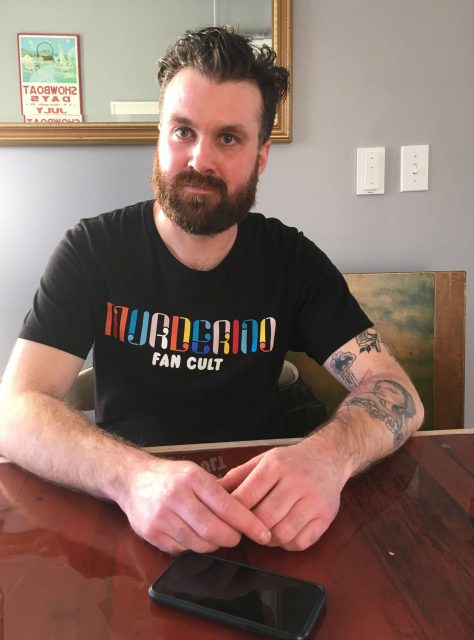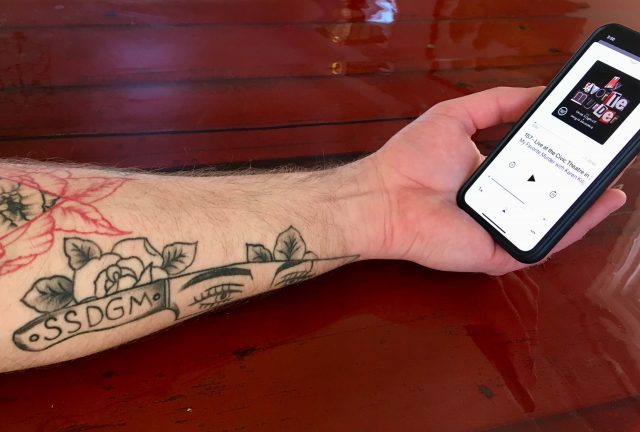By Katie Moritz | Rewire
Charles Brandes was a true crime late bloomer.
Lots of the people who now claim true crime as an obsession got hooked watching “Forensic Files” and “Unsolved Mysteries” reruns as a kid. But Brandes, a 31-year-old from Minneapolis, got his start when everything changed for the genre a few years ago. In 2014, the podcast “Serial” hit the scene.

“It wasn’t something I had sought out until recently,” Brandes said. “And when I did… I just really loved it, I loved listening to the podcasts and watching shows.”
And while the macabre is what hooked him, something else is keeping him around. Something you wouldn’t necessarily expect in a community of crime-obsessed people.
The more traditional true crime podcasts “led me into ‘My Favorite Murder’ and ‘The Last Podcast on the Left,’” he said. They “take more of a humorous note on true crime and making fun of it.”
The hosts of both shows also spend a lot of time talking about mental health.
They’ll “talk about their own mental health and seeking therapy and medication and whatever it is that makes them okay and able to function,” Brandes said.
“It’s really nice to see that normalized… because so often mental health and seeking help is demonized. That’s something… that has attracted me to these things.”
The frank discussions have helped him, he said. They’ve inspired him to improve his self-talk, as well as his habits around mental health.
There’s also a robust online community of “Murderinos,” as “My Favorite Murder” fans call themselves. Brandes is a member of the Minnesota Murderinos group on Facebook, which he calls “a community of people to rely on or talk to when things are going bad.”

“It’s a close-knit community, it’s cult-like in nature and it’s… positive and welcoming,” he said. “It’s been really important to me.”
So much so that he got it memorialized on his body last year. Brandes has a “My Favorite Murder”-inspired tattoo: eyes reflected in the blade of a knife with the letters “SSDGM” on the handle. That stands for “Stay sexy, don’t get murdered,” which is how the hosts sign off at the end of every episode.
True crime boom
Brandes is hardly the only person with a true crime-inspired tattoo. There are more than 200 posts tagged with #ssdgmtattoo on Instagram, and hundreds more photos on Pinterest.
So, what pushed true crime, a genre that has been around forever, from a low-brow guilty pleasure to a full-on obsession, complete with a built-in network?
Are there any sweeter words in the English language than “there’s a new Ted Bundy documentary on Netflix”?
— Jill Filipovic (@JillFilipovic) January 25, 2019
Part of it comes down to numbers. With the overwhelming success of “Serial” came an avalanche of other stories — more podcasts, television shows, documentaries, miniseries and books.
Something that had once been consumed in private was thrust into the spotlight because of sheer volume.
“Where we are in the digital age with social media and the web and mobile, stories that may have been folklore in the past, not fully reported on, not public, are at our fingertips,” said Jen Sargent, chief operating officer at Wondery, the podcast publisher behind a true crime lineup that includes “Dirty John,” “Dr. Death” and “Gladiator.”
“Any crime that happened in the past 20, 30 years is really available. They don’t all make good stories…, but I think it’s more acceptable now, more talked about and more reported on than ever before.”
The increased accessibility has led to desensitization, too, said Gail Saltz, clinical associate professor of psychiatry at the New York Presbyterian Hospital, Weill-Cornell Medical College. And desensitization helps the true crime snowball grow.
“We’re increasingly desensitized to just about everything that’s been taboo,” she said. “It used to be that revealing that you wanted to look at horrible things would reveal that that was a desire for you. … Over time it’s become less stigmatized and everyone’s acknowledging they want to look.”
For the most part, she said, “that’s a plus — stigmatizing urges and fantasy and thought is not a useful thing, at least in my world of dealing with mental health and mental health issues.”
While “true crime” is often assumed to mean grisly crime, content creators and journalists realized the true crime model could be applied more widely. Blake Ellis and Melanie Hicken are investigative consumer reporters for CNN who found themselves jumping into the true crime world when they got on the trail of a French scammer.
Their journey to find the mythical psychic behind a huge, international fraud was serialized on CNN’s website, and later developed into a book, “A Deal With the Devil: The Dark and Twisted True Story of One of the Biggest Cons in History.”
“When you think of true crime you think of murder and serial killers,” Ellis said. “Our book is about this massive consumer fraud… and it seems like people have become fascinated by all kinds of true crime.”
The variety allows skeptics to get their toes wet in the genre before going full-tilt serial killer. Besides, all the gore can get a little monotonous. Between scammers, cults and bad doctors, “true crime isn’t just murder anymore,” Ellis said. “That really makes it more interesting.”
Anybody can be a detective
True crime has also opened the reporting process to consumers. Podcasts like “Someone Knows Something,” “Missing and Murdered” and “Up and Vanished” feel like they’re unfolding almost in real time, as the hosts follow leads, get lucky breaks and hit dead ends.
In a time of intense media skepticism, this transparency — getting to see exactly what’s being done to find answers — can be a comforting breath of fresh air.
View this post on Instagram
Hicken and Ellis didn’t wait to start their written series until they had all the loose ends tied up.
“We actually wrote the stories about (the scam) as we were reporting,” Hicken said. “We started writing about it before we knew much about what was behind the scam. We took people along with us as we learned.”
There’s also an exciting element of audience involvement. “Being able to follow along and be able to participate in solving the mystery” is a big part of the true crime zeitgeist, Ellis said. Tips “can help actually shape the rest of the story.”
“We loved having all of these armchair detectives sending in their own tips and doing their own research on the fraudsters that were behind this massive scam,” she said.
“That is really what led to the book, because the story didn’t go away even after we had published these stories,” Hicken added. “It took us all the way to France, where we tried to confront this woman.”
In Wondery’s case, a listener tip sent in when “Dirty John” was released inspired “Dr. Death,” Sargent said.
“We had such… incredible outreach from listeners, and one of the tips was from someone who was a former classmate of (‘Dr. Death’ subject Christopher Duntsch),” she said.
“We looked into it, it was interesting enough to hire an investigator in Texas. A year later it ended up becoming a podcast and becoming (a top podcast of the year).”
The fandom’s excitement is enough to keep true crime producers wanting to make more.
“It’s been a really fun dynamic to experience,” Sargent said. “We get, ‘When’s the next thing coming out? What should I listen to after “Dirty John” or “Dr. Death”?’”
What killers and scammers can teach us
Sound reporting aside, there’s something about crime that will always fascinate us. Our desire to consume this kind of content is linked to “our normal sadomasochistic and voyeuristic urges,” Saltz said. Because of that, it’s probably not going away any time soon.
“Watching true crime stories is a bit of identifying with both the perpetrator, who has the power, and the victim,” she said. “But one step removed, like a horror movie — but it’s even more titillating, because it is real.”
And because it’s such a gripping genre, “true crime offers the opportunity to (both entertain and educate),” Sargent said.
“There’s a lesson to learn from it: In terms of protecting yourself, asking the right questions, being aware of your surroundings…, always questioning what comes across your desk.”
Brandes said he’s glad crime storytelling has been normalized. After all, these stories are part of our reality, and our identity.
“I think some people felt weird about it in the past, like there was something wrong with people who were interested in such a macabre thing,” Brandes said. “But (they are) things that really happen.”
What’s your favorite true crime podcast, show or book that’s not talked about enough? Share in the comments. Seriously, we’re getting too close to the end of our listening queue for comfort.
![]() This article originally appeared on Rewire.
This article originally appeared on Rewire.
© Twin Cities Public Television - 2019. All rights reserved.
Read Next



